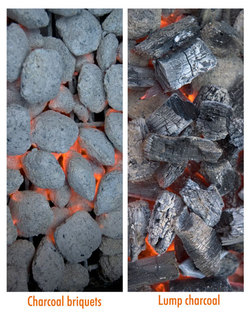
An outdoor grill may seem simple, but it is actually a complex cooking tool, and understanding how it works is crucial to making great food outdoors, and a necessity before handing your credit card to the clerk.
You may have thought you left physics and chemistry behind when you left school, but if you want to eat well, you need to understand that cooking is all about physics and chemistry, with a little magic mixed in. Here are some broad concepts every outdoor cook needs to know.
What is cooking?
The four ways heat cooks food. Food gets hot when molecules vibrate so fast that their temperature rises. Heat is transferred to food by means of conduction, convection, radiation, excitation, and induction.
The processes can be described this way: Conduction is when your lover's body is pressed against yours. Convection is when your lover blows in your ear. Radiation is when you feel the heat of your lover's body under the covers without touching. Excitation is when she talks dirty to you on the phone. And induction is when she gives you electric socks.
Let's be a bit more precise:
Conduction is when heat is transferred to the food by contact with the heat source. Cooking a hot dog in a frying pan is conduction. As the surface of meat gets hotter than the interior and the heat transfers to the center through the moisture and fats, that's also conduction.
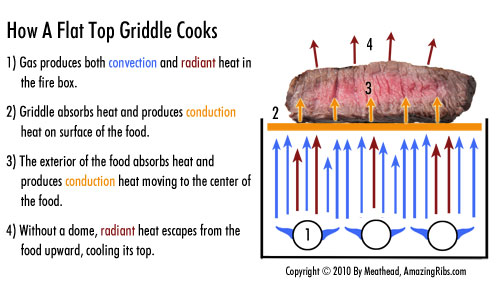
Convection is when heat is carried to the food by a fluid such as air, water, or oil. Cooking hot dog in your kitchen oven where it is surrounded by hot air or deep frying it is convection. The interior of the meat, however, is cooked by conduction as the heat travels through it.
Radiation is the transfer of heat by direct exposure to a source or energy. Grilling a hot dog directly over hot coals is radiation with the exception of the parts touching the hot grates. They cook by conduction.
Excitation is how microwave ovens work. Microwaves are radio waves that penetrate the food and vibrate the all the molecules inside the hot dog at once until it gets hot without heating the air around it.
Induction is the latest technique for stove tops. An copper coil is placed under a smooth cooktop and an alternating current is sent through the coil creating a rapidly changing electromagnetic field. Electrons in conductive steel or cast iron pots placed above the electromagnet are jostled by the rapidly changing magnetism, but they resist and get hot. The pot then conducts the heat to the hot dog without the cooktop or the air around it getting hot. Induction is very responsive to the control knob and is extremely energy efficient, but it does not work with aluminum, glass, or copper pots.
The different types of grill
Let's start with the different fuels: Charcoal, gas, wood pellets, or electric.
Charcoal
Likewise, I won't get into the long religious discourse over which is better, charcoal or gas, but I will send a few of you hurling off the deep end by saying that flavorwise, the taste differences are negligible between charcoal and a really hot gas grill, especially on quickly cooked foods like burgers or steaks. For the charcoal devotees, ask yourself this: Remember the best steak you ever had? At a steakhouse, right? What fuel do they use at almost all the great steakhouses? For more about the topic, and especially before you start calling me an idiot, read my article Charcoal vs. Gas Grill Throwdown. If you are shopping for a charcoal grill, read my article Reviews of Charcoal Grills.
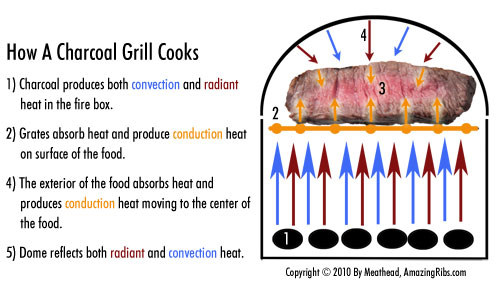
Gas
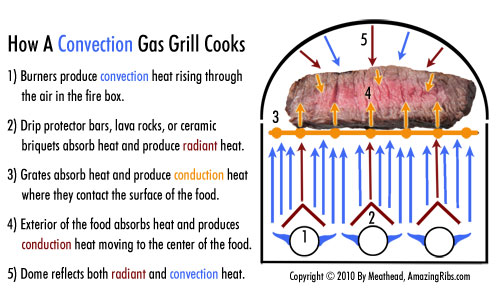
In the past few years a number of gas grills have been touting their superiority because they use "infrared" cooking. What the marketing guys really meant when they called their newfangled cooking systems infrared, was radiant heat because there is a radiant surface, a plate of glass, ceramics, or metal, between the burners and the cooking grates. The radiant surface absorbs the heat from the flame and radiates it to the food.
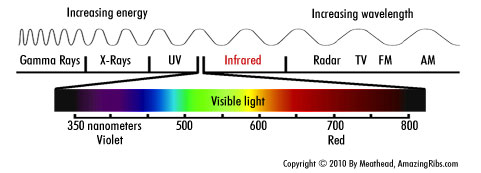
The advantage of radiant heat is that it is more efficient than convection, it gets hotter than convection, often in the 500 to 700F range, there is less dry air motion, and less moisture is lost. Also, the radiant surface is usually very close to the food so dripping juices or marinades incinerate and go right back up into the meat, adding flavor without flareups. The results are indistinguishable from charcoal. Worth it? Yup. Especially if you want good browning. And you do, because browning creates flavor.
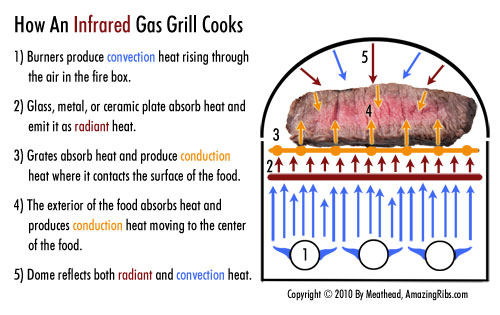
If your grill doesn't have infrared, you can add it with a new commercial product called GrillGrates. They replace the manufacturer's grates or sit on top of them and act like infrared generators. Read more about GrillGrates here.
If you are shopping for a gas grill, read my article Reviews of Gas Grills.
Wood Pellets
Electric Grills
Shopping for a grill or smoker
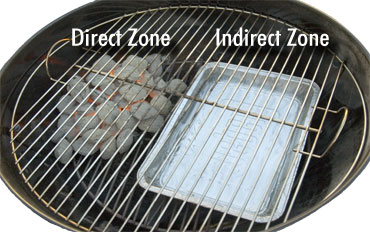
Charcoal grills should allow you to bank the coals on one side and leave the other side without coals. They need tight lids and dampers that can be opened or closed to control oxygen to the fire and thus control the heat. Some have the ability to raise and lower the coals. This is a very good thing because heat dissipates according to the inverse square law which states that the energy delivered to the meat is inversely proportional to the square of the distance from the source of the energy. In plain English, this means that means that if the charcoal is 2" from the meat there is 4 times as much energy delivered to the meat than when the coals are 4" away, not double.
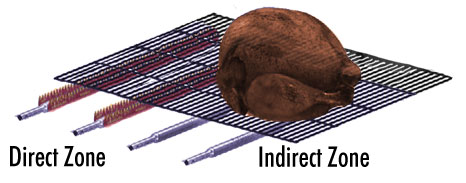
For gas grills, you want at least two burners so one can be on and one off. But the more the better. With three or four burners you can have hot, medium, and low zones. You also need a lid that closes fairly tight for smoking. Alas, very few gassers seal tightly. You also want even heat across the cooking surface. Watch out for hot spots over the burners.
Other important features. When shopping for a grill, in addition to price, you want to consider size of the cooking surface, size of the grill's footprint, space under the hood, the maximum heat, minimum heat, quality of construction and materials, what the grates are made of, rotisserie capability, thermometer, side shelves, side burners, ease of cleaning, ease of assembly, safety, warranty and support, and accessories. For more on what to look for when shopping for a grill, read my article How to Buy a Grill.
Tell me about your grill and what you like or hate about it.
----------------------------
All text and photos are Copyright (c) 2010 By Meathead, and all rights are reserved. For more of his writing, photos, and recipes, please visit him at AmazingRibs.com.
 Follow HuffPost Food on Twitter and Facebook!
Follow HuffPost Food on Twitter and Facebook!
